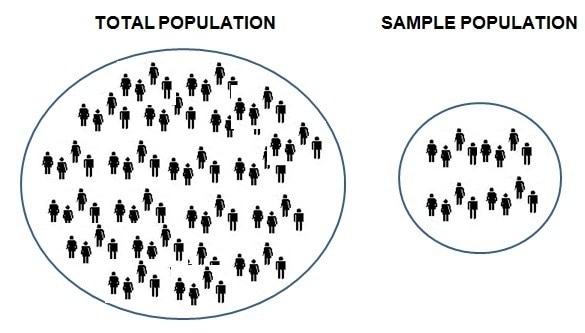
What is Sampling plan and how to make a sampling plan for research?
What is Sampling plan and its application in Market research?
Once you are ready with your market research plan, then comes the implementation part. And the first step of implementation is determining your sampling plan.
A sampling plan basically comprises of different sample units or sample population whom you are going to contact to collect market research data. This sampling unit is a representative of the total population, though it might be a fraction of the total population.
In simple language, if you have 1 lakh customers, you cannot conduct an interview of 1 lakh customers. Instead, you take a sample population of 1000 customers (1 % of your total population). This sample gives you primary data and this is assumed to suit 99% of your customers. Naturally, the 1% whom you have interviewed need to be important to your company. And hence the need of a sampling plan.
There are four steps to making a Sampling plan for Market research.
Table of Contents
1) Define the sample population
More commonly known as the Sample unit, it comprises of the type of customers / people that you want to contact for your market research study. To determine the sample population, first you need to decide what the ideal customer for the firm looks like.
If yours is a restaurant, you will like your sample population to comprise of people who have visited at least 5 times to your restaurant. They will be a fair judge of things you can improve on. Or on the other hand, you can interview people who are just walking in, if you want to improve the ambiance of the restaurant and note down their ideas.
Overall, you need to understand that you cannot interview 100% of your customers. Hence the Sample population will be a small population which will be extrapolated later on. So this step is important and you need to choose your customers with care. They should be a strong representative of the type of business you want to become.
2) Define the size of the population
In the above example of a restaurant, the market research can have 1 of two objectives
- To find out what makes old customers happy
- To improve the ambiance of the restaurant which can be suggested by new people entering the restaurant.
In the above example, in Case A, you need to approach a hand picked customer base who have visited your restaurant time and time again and you need to implement what they say. This customer base can be anywhere between 50 to 200 of your most valuable customers.
In case B, where you want to improve the ambiance of the restaurant, every new comer who is new to the restaurant will have a different suggestion. And the research will be endless, so you can put a questionnaire right at the table for things the customer will like to improve.
Thus as you can see, the sampling size and the size of the population in the sampling plan changes as per the objective of the market research. If the objective is an ongoing objective to make something better all the time, then the population will be large. If it is something you need to determine within a given time period, then the population will be less but it should be important.
Once your Sampling size is decided you can decide on the contact method for your sampling plan.
3) What type of contact options are you using
There are many options in Market research which can be used time and time again to carry out primary data collection. These options include questionnaires, mailers, telephonic interviews and whatnot.
Your contact options depend on your sampling size and your sampling units. If your customers are the busy types and there are a handful of them, then personal interviews with an appointment will serve you perfectly. However, if your customers keep coming and there is a large population of them, then it is manually not possible to touch each and every one personally.
So your sampling plan and its contact method will depend on the size of the population you are going to contact. Mind you, large companies still prefer contacting their customers personally to get personal feedback from them. But smaller companies have various options such as telephonic interview or Forms and questionnaires or mailers to get the work done smoothly.
4) Form a sampling frame
So once you have the sampling units, the sample size and the population you are going to contact, you decide on the contact plan. You need to put it on paper whom you are going to contact when. A market research study might take a single day (in which case you dont need a sampling frame) or it may take months (in which case you definitely need a sampling frame).
Think of a sampling frame as an organizer. If you are too busy, then you are better off with an organizer in your sampling plan. However, if the work is going to get done quickly, then you dont need the sampling frame at all. If you expect facing any problems or questions when the process starts, then you can prepare the sampling frame to answer such questions. It can be the FAQ of your market research plan.
How are you going to analyse the results? – In the sampling plan, you need to decide on the analysis part as well. There are two ways to analyse the results of a Market research study
a) Probabilistic sampling – Most likely to be used for quantitative research, it can pin point sampling errors and therefore gives a correct data. However, it is heavy on time consumed for analysis. It uses mainly an objective questionnaire with proper “Yes / No” type questions and statistical answers.
b) Non probability sampling – It is used mainly for qualitative research wherein you can marketing and customer insights as it is not data based but more based on the quality of the answers. This is more of a subjective questionnaire then objective.
The type of analysis you are going to carry out (probability or non probability) has to be determined in the sampling plan because you need to contact the customers accordingly. Do note, that this has to be incorporated in your market research study so you need to decide your population accordingly as well.
Overall, once you are done with the 5 steps of sampling plan given above, then you are done with the following process
- Who are the customers you are going to contact
- How many customers you are going to contact
- How will you contact the customers
- What is the time frame or the contact frame for getting in touch with customers
- What is the analysis method you are going to use later on.
Once you do the above, you are ready with your sampling plan.








